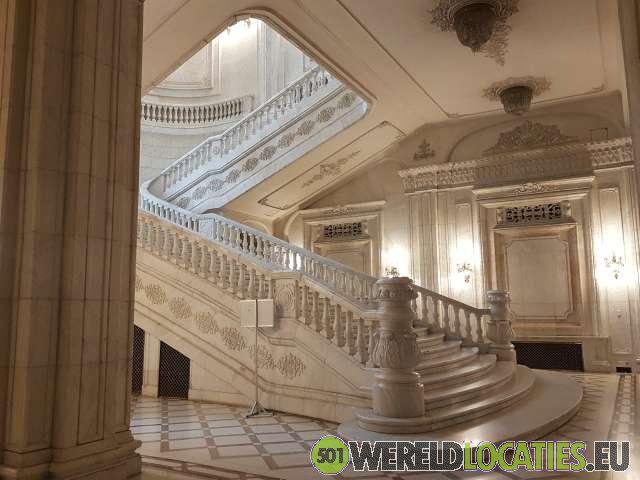
Foto: The enormous parliament building (bron: Ronald van der Veer)
Romania - On the opposite side of the Dâmbovița River stands the Parliament building. It is the second-largest building in the world—only the Pentagon in the United States is larger. Dictator Nicolae Ceaușescu ordered the construction of this massive structure in 1984. When he was overthrown and sentenced to death in 1989, the building was still not finished. It was decided to complete the structure, as many of the required materials had already been ordered. Construction was completed in 1997. From the six-kilometer-long boulevard, we can already see the Parliament building. We walk toward it. At three o'clock, we have a guided tour reserved. Since the building is so large and we’re unsure which entrance to use, we allow some extra time. A taxi driver in the square in front of the building points us to the right side. Moments later, we enter the Palatul Parlamentului. Arina welcomes us for the tour. First, our passports are scanned, followed by an airport-style security check. The building was designed by a then 21-year-old woman. More than 700 architects worked on its construction. The work continued 24/7 in shifts. Arina shows us the grand halls, various conference rooms, and the massive ballroom. This room spans more than 1,000 square meters and is an astonishing 19 meters high. Everything in the building is oversized. It’s almost surreal to think that something like this was designed so recently. Via the grand staircases, we reach the balcony. From here, the boulevard is clearly visible—it’s even longer than the Champs-Élysées in Paris. It’s unimaginable how many homes were cleared to make this massive project possible. At the end of the tour, Arina tells us we’ve walked two kilometers inside the building and that we’ve seen less than five percent of it.



Video
ClujNapoca the Cultural Heart of Transylvania
Romania - Cluj-Napoca, often simply referred to as Cluj, is one of Romania’s most important cities and is considered the cultural and economic capital of Transylvania. Located in the northwest of the country and surrounded by the hills of the Apuseni Mountains, ...
Draculas Castle
Romania - After more than two hours of driving, we reach the exit to Bran. Via fifteen sharp hairpin turns, we descend to the lower landscape. Then, a straight road leads to the castle. As we enter the village, we already see the castle on the hillside. Clearly, ...
Old town of Bucharest
Romania - From the hotel, we walk into the city. We’re looking for the Darvari Hermitage Church. This is the first stop on a walking tour from the guidebook. A service is underway in the church. Notably, only women are present. We quietly observe from the back. ...
Sighisoara the Medieval Pearl of Transylvania
Romania - Sighișoara is one of the best-preserved medieval towns in Europe and is located in the heart of Transylvania, Romania. The town was founded in the 12th century by Saxon settlers, also known as Transylvanian Saxons, who were invited by the Hungarian king ...
The Alba Carolina Star-Shaped Citadel
Romania - Alba Carolina is an impressive star-shaped citadel located in the city of Alba Iulia. Built between 1715 and 1738 by order of the Habsburg monarchy, it is one of the largest and best-preserved fortresses in Southeastern Europe. The citadel was designed ...
The History of Salina Turda
Romania - The history of Salina Turda dates back to Roman times, when the area around Turda was already known for its salt mining. The first written mention of the mine comes from 1271. During the Middle Ages and the Hungarian-Romanian period, the mine produced ...
The monasteries of Bukovina
Romania - In the region of Bukovina, where we’re staying, monks had a stronghold in the 16th century. Due to frequent Ottoman attacks, they built fortified monasteries in the mountains. These also provided shelter to villagers during attacks. The monasteries ...
The Royal Castle of Pele
Romania - Peleș Castle, located in the picturesque town of Sinaia in Romania’s Southern Carpathians, is one of the most beautiful castles in Europe. Built between 1873 and 1914 on the orders of King Carol I of Romania, it served as the royal family’s summer ...
The Transfagarasan Highway, Romanias Most Spectacular Road
Romania - The Transfagarasan Highway, also known as DN7C, is one of the most scenic and dramatic roads in Europe. Winding through the rugged Fagaras Mountains in central Romania, it stretches over 90 kilometers and connects the regions of Transylvania and Wallachia. ...
 Uzbekistan - Samarkand Registan Square
Uzbekistan - Samarkand Registan Square












